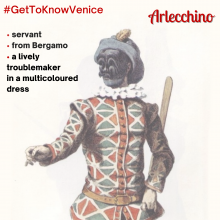Carnival's origins are centuries old, and it still attracts thousands of tourists each year who arrive in Venice to admire the sumptuous costumes and masks parading in the streets and squares. The magic of carnival gives to Venice an enchanted atmosphere. Masked people fill the streets with smiles and laughter, and several events are organized all around the city.
The carnival became a public festivity in 1296, with an act of the Senate of the Republic of Venice, but its origins are even older. Already in 1094, official documents brought traces of public celebrations in the last days before Lent. At this time, and for the following centuries, the carnival consisted in several weeks of festivity and fun in the whole city, during which people could indulge in music, dances and parties. Wearing masks and costumes made it possible for people to hide any differences of class or status, and it was even allowed to make fun of the aristocracy. This time of regulated social outburst was a way for the most Serene Republic of Venice to maintain order and power throughout the rest of the year.
Venetian Masks
Since the ancient carnival times, the habit of wearing masks and costumes has given birth to a flourishing trade, with specialized artisans producing more and more extravagant and sophisticated masks.
Some of the most famous ones are:
- Arlecchino (French: Arlequin, English: Harlequin) typically depicted in multicoloured costume comprised of diamond shaped patterns;
- Pulcinella (related to the Italian: pulcino or chick) is a crooked-nosed hunchback. He was the model for Punch in the English puppet theatre Punch and Judy. He is associated with Naples;
- Colombina (also known as Columbine and Columbino) is a half mask often highly decorated with gold, silver, crystals and feathers.
Let's find out something more about this magic festivity!
- The Saturnalia: Carnival’s celebrations are very ancient, they have their origin in the Saturnalia, a roman festivity that took place at the end of December in honour of the god of agriculture.
- Carnival days: The days of Carnival change every year, depending on the Easter week. The most important days are Giovedì grasso (“fat” Thursday), Carnival main day and Martedì grasso (“fat” Tuesday), last day of celebrations.
- Carnem levare: The name of this celebration has latin origins: carnem levare (remove meat). It refers to the fact that was used to finish all the stock before the Lent, in which you are not supposed to eat meat.
- Confetti: Before switching to the paper version, coriander seeds cover with sugar were thrown up in the air during ceremony and parties. They were called “confetti” in Italian, or “coriandoli” referring to the plant that produces them, this explain to two most famous variants of the name.
- The most famous Carnival celebrations: As is well know the most important Carnival celebration in Italy is in Venice, but there are at least two other famous places: Viareggio in Tuscany and Acireale in Sicily where parades of allegorical floats are organized.
Now let's have a look at some local traditions related to Carnival celebrations:
- Festa delle Marie: since 9th century, every year, a collective wedding ceremony of 12 girls, among the poorest and most beautiful, was celebrated in the church of San Pietro di Castello. In 946 a group of Dalmatian pirates broke into the church and kidnapped the girls. Nowadays, during Carnival, a great procession takes place, in which 12 Venetian girls parade from San Pietro di Castello up to San Marco square to celebrate the victory on the pirates.
- Commedia dell'Arte: the famous “Italian comedy” is a form of theater that seems to be inspired by the Venice carnival. The actors did not recite texts but improvised dialogues on stage and impersonated stereotypical characters. Carlo Goldoni, one of the most famous Venetian playwrights, used these characters in his comedies.
- Fritoe: the "fritoea or fritola" in Venetian dialect is the queen of Venetian sweets. It is and it has always been considered the national dessert of the Serenissima Republic.
- Taglio dea testa del toro: the Cutting of the Head of the Bull derives from an event happened in 1162, when people celebrated the victory of Doge Vitale Michiel II over Patriarch Ulrico of Aquileia and his 12 feudal lords. The insurrection was suffocated in blood and after that, every year the successors of the Patriarch had to send a bull, 12 loaves and 12 well-fed pigs as a compensation to the Doge in charge. The bull (=Patriarch) with the 12 pigs (=feudal lords) were mocked in the public square with a ritual that included the spectacular cutting of the bull's head.
- Volo dell'Angelo: the Flight of the Angel was introduced in Venice around the 16th century. In this occasion a Turkish acrobat managed to cross Piazza San Marco, walking on a very long suspended rope. Today the honor of being the Angel is reserved for the most beautiful Maria of the previous year.










Follow us